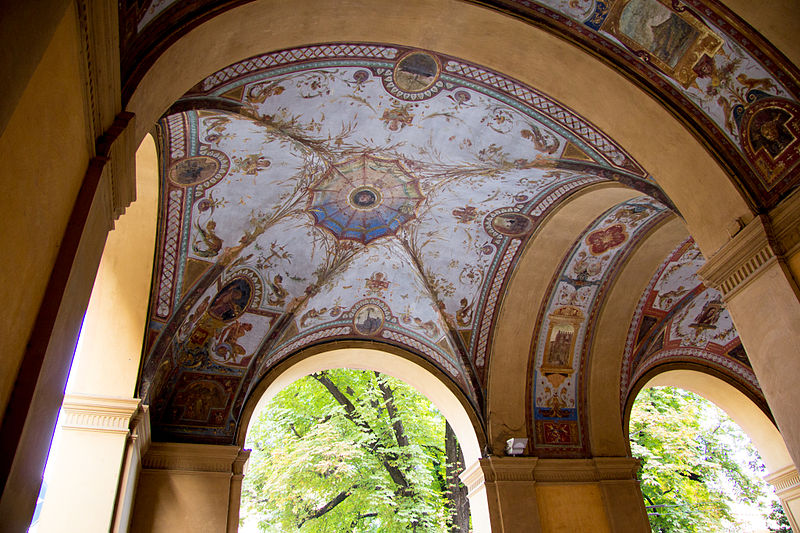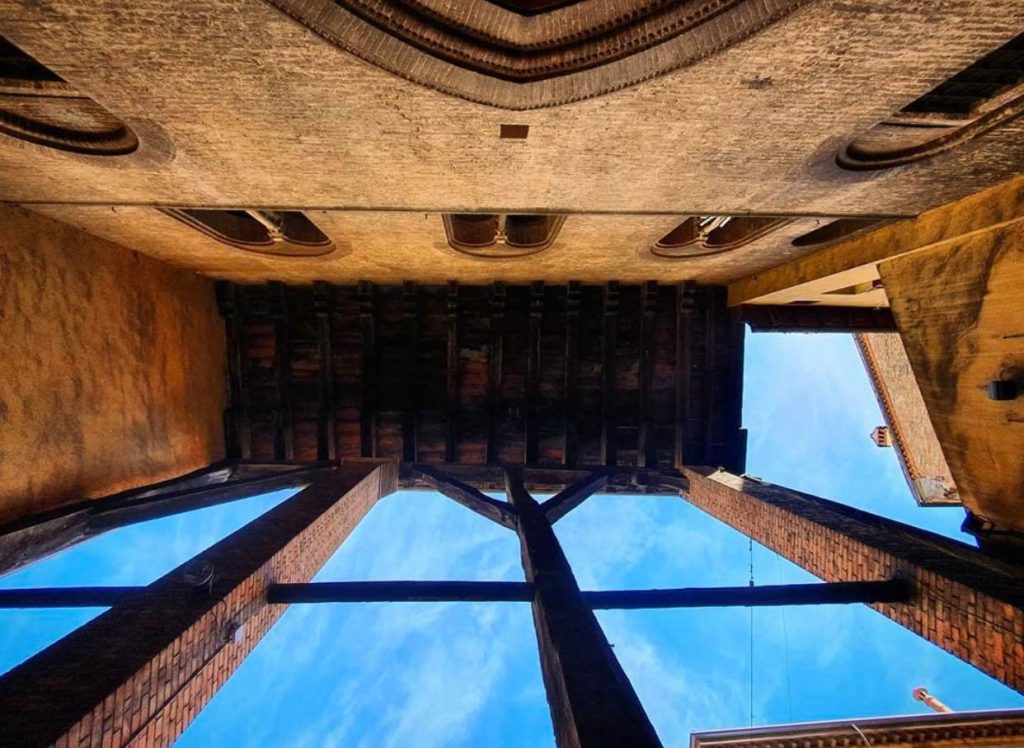Sometimes we get distracted by our thoughts or our phones, and we miss out on some of the most wonderful treasures and quirks of Bologna. Here is a small collection of legends and artworks you can only discover if you keep looking up.
Madonna del Campanello
In this case, looking up isn’t always enough. You also have to be in front of the Two Towers on the right day! The Madonna del Campanello can be found on the façade of Palazzo dei Drappieri, in piazza di Porta Ravegnana. At the center of the façade, there is a balcony covered by a red cloth that hides a statue of a Madonna and Child by Gabriele Fiorini. This statue can only be seen one week a year when the Madonna di San Luca descends into the city. To celebrate this moment, the bell placed next to the Madonna del Campanello is rung, which is why the Bolognese know her as the “Madonna of the Bell”.
The frescoes under the portico of Palazzo della Banca d’Italia
Walking under the elegant portico of Via Farini, headquarters for the Bank of Italy, there is one particularly fascinating detail: the ceiling. Each section of the portico is decorated with beautiful frescoes, staring historical figures and facts, in a succession of images that lead back to the foundation of the Roman Empire with the Capitoline she-wolf nursing Romulus and Remus. Then comes Julius Caesar and Napoleon Bonaparte, Galileo Galileo, Raphael and Michelangelo, not to mention the great geographical explorations, technological discoveries, and locomotive innovations. In short, this stretch of portico is a journey through the main points in history that have created our country – from ancient times to the more modern era – all thanks to the frescoes by Gaetano Lodi.
The three arrows of Corte Isolani
What better reason to keep looking up than to search for the three arrows stuck under the portico of Casa Isolani? This is where, in Strada Maggiore, thousands of tourists constantly scan the ceiling for the arrows described in legend, supposedly meant to execute the lady who once lived there, sentenced to death for adultery. As she waited for the archers to strike their deadly blow, the woman suddenly threw off her veil, distracting the archers with her beautiful face. Their aim disrupted, the arrows ended up in the ceiling of the portico and the woman was saved. Have any of you managed to see the arrows?
The coffered ceiling of the Archiginnasio Anatomical Theater
Now we move indoors to admire one of Bologna’s most precious jewels: the Anatomical Theater of the Archiginnasio. Its wooden coffered ceiling, built in 1645, is still decorated by symbolic figures representing the fourteen constellations with Apollo in the center, the god of medicine. A decoration that expresses the conception of man and his existence in relation to nature. This theme refers to a time when it was a regular practice to consult the stars before any interventions or operations, thus associating astrology with medicine. This was once perfectly normal, especially if you consider the fact that astrologers were also consulted before wars, political agreements, or any decisions for the construction of buildings.
The statue of Gregory XIII
Bologna’s most famous square, Piazza Maggiore, contains a large statue of Gregory XIII. Keep this name in mind, because the inscription that accompanies it will try to convince you that it is actually San Petronio, not the Pope. Why? It was a clever trick to protect the statue from Napoleon. The famous general was violently raiding all of Italy’s treasures and artworks, along with the suppression of all religious orders including the destruction of statues dedicated to popes and emperors. The statue of the Bolognese Pontiff Gregory XIII was listed among the intended “victims” of these raids, so the Bolognese hatched a plan: they cast a miter and a bishop’s crosier and added them to the statue, transforming him into San Petronio, complete with an inscription. Thus the statue was saved and the inscription was left, dedicated to the city’s patron saint.
Have you seen other beautiful details around Bologna that look down from above?
Let us know at ufficio.stampa@succedesoloabologna.it
Discover Bologna with us







